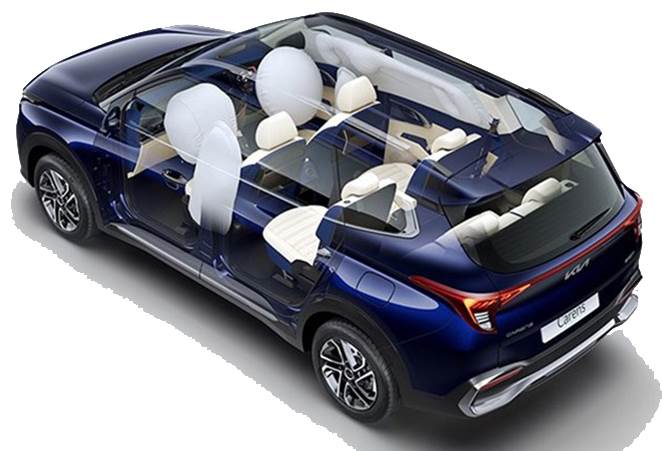German automotive major Continental’s Indian arm – Continental Automotive India – is targeting 12% year-on-year growth in CY2024, aiming to ride on the strong demand emanating from the domestic automotive market as a result of the country’s robust macroeconomics.
To achieve this growth, Continental Automotive India plans to expand manufacturing capacities across its three key product lines – airbag control unit (ACU), telematics control unit (TCU), and tyre pressure monitoring system (TPMS) sensors – at its plants in Bengaluru and Manesar.

Six-airbag OEM focus drives demand for ACUs
“We are adding more capacities on the airbags front as there is a growing demand for ACUs with an increasing number of cars switching to standard six airbags. We are expanding the ACU capacity in Bengaluru from the existing 2 million units to 3.5 million units in CY2024,” Prashanth Doreswamy, President and CEO, Continental Automotive India, told Autocar Professional.
As the company readies to introduce its 5G-enabled telematics control unit for one of its key customers in India’s passenger vehicle segment later this year, Continental Automotive India has set up a new TCU line, which is currently undergoing pre-production and trial runs. “It is altogether a new line and we will have a capacity of a little less than a million units at SOP later this year,” informed Doreswamy.
The company says the product will see application in seven models after its launch, and therefore, Continental will adopt a phased approach to expand the TCU manufacturing capacity. “Finally, we will go up to 2 million units in annual capacity,” he pointed out.
“Lastly, we will be adding an additional line for TPMS sensors over the next few months,” Doreswamy added. While the Tier-1 major has installed a near-4-million-unit annual capacity TPMS line, Continental Automotive India aims to ramp it up to 10 million units in a phased manner again.
The company began TPMS supplies in India around two months ago to its customers in the premium as well as volume segments, and says it has acquired more business from Indian-origin- as well as global OEMs operating in India, with supplies to them slated to commence later in CY24.
“We plan to hit full capacity utilisation by end-CY2025, and will adopt a phased expansion approach for TPMS to 10 million units. We plan to export TPMS sensors in the second phase as well,” Doreswamy said.
Localisation focus to enhance product value
According to Doreswamy, India is a value-driven market and making products affordable is the biggest challenge. “Therefore, we are ensuring to localise whatever is possible, except for the active and passive electronic components in our products. Otherwise, much of the components are localised in India,” he said.
The company says despite the PLI schemes in action, it will take at least another 2-3 years for the electronic supply chain to get established and stabilise in India.
With the growing demand for digital instrument clusters, Continental is also localising digital clusters in India. “We will be starting with a 10.25-inch cluster, which will be locally produced in Bengaluru. We will supply it to an Indian OEM later in the year,” said Doreswamy. While the company will import the display itself, it will localise the remaining components of the digital clusters.
 With growing connectivity in vehicles, Continental foresees strong demand for zonal computers. It is developing high-performance computers (HPCs) for new-gen vehicles slated to hit the market in the next 2-3 years.
With growing connectivity in vehicles, Continental foresees strong demand for zonal computers. It is developing high-performance computers (HPCs) for new-gen vehicles slated to hit the market in the next 2-3 years.
Connectivity and ADAS to drive future growth
Continental Automotive India, which grew at almost double the market growth rate in CY2023, and registered around 18-20% YoY growth, expects to continue the momentum this year as well. While the passenger vehicle segment’s growth is likely to moderate at 5-7 percent in CY2024, “we should be able to grow at 10-12% in CY2024,” said a confident Doreswamy.
As per the company CEO, while India’s accelerated push towards global safety standards over the past half-a-decade drove business from its safety products, it now anticipates future growth to come from connectivity and ADAS technologies.
“The last five years saw a rapid introduction of several new technologies, with the government’s efforts to bridge the gap between safety standards in vehicles in India and Europe. Therefore, our growth was much higher in safety domain products, be it airbags, ABS, ESC, and wheel-speed sensors, among others.”
“However, now that these features have become mandatory, we expect future growth to come from connectivity and assisted functions (ADAS) products,” Doreswamy explained.
“With increasing connectivity in vehicles, we are witnessing growing demand for zonal controllers, which are moving out of the vehicle’s body control module or BCM. We are also working on high-performance computers (HPCs) for new-generation vehicles that will be coming with new architectures.
“Therefore, we see growth in the next 2-3 years coming from connectivity and ADAS solutions,” concluded Doreswamy.
